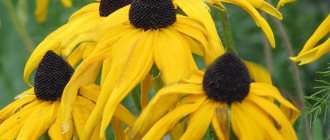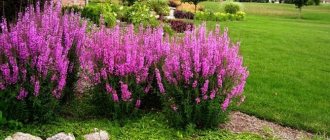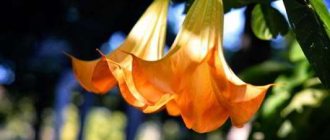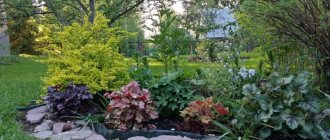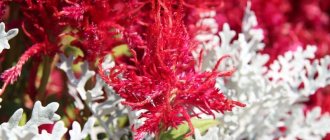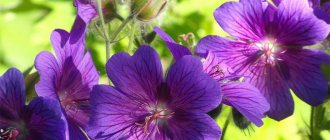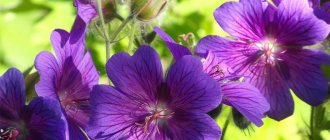The flowering plant Diascia belongs to the Norichaceae family. This genus includes 68 species, which are represented by evergreen or semi-deciduous annuals and stolonous perennials. This plant comes from South Africa, where it grows mainly in mountainous areas. This plant is quite popular among gardeners in European countries. As a rule, perennial species prefer to grow in the mountains, and annuals on arid plains. Diascia is cultivated in open ground as a border plant or in a flower bed, and it can also be grown in containers or hanging structures.
Brief description of cultivation
- Bloom . Flowering begins in the first days of June, and ends with the first frost.
- Landing . Seeds for seedlings are sown from the last days of February to the first days of March, the seedlings are transplanted into open soil in the second half of May.
- Illumination . Needs a lot of bright light.
- Soil . It should be slightly acidic, moist, not too nutritious and include a little sand.
- Watering . During hot, dry periods, as well as after pruning in the summer, water frequently and abundantly. If it rains systematically in the summer, then the diassia is watered moderately, but this is done systematically.
- Fertilizer . The flower is fed regularly once every 4 weeks; for this purpose, mineral fertilizer for flowering garden plants is used, and the dosage recommended by the manufacturer on the packaging must be halved.
- Trimming . When the bushes bloom for the first time, the stems are shortened by ½ part of their length.
- Reproduction . Cuttings and seed method.
- Harmful insects . Slugs and snails.
- Diseases . Stem and root rot.
Spreading
Under natural climate conditions, it grows in arid areas with a lot of heat. Sunny, hot places are ideal for diascia. Some varieties get along well in moist, well-drained soil. The plant can also be found in mountainous areas. Therefore, the tropical region of South Africa became the birthplace of the flower.
Artificially created diascia hybrids are found on almost all continents. Thus, cultivated varieties withstand moderate climate conditions well. The crops grow throughout Russia and the Caucasus. Annuals grow in the mid-latitudes of Asia.
Features of Diascia
Depending on the type, the shoots of diascia can be creeping, erect, or lodging. Under natural conditions, the height of a bush can reach up to 100 centimeters, but in cultivation they are not higher than 20–35 centimeters, while some of their shoots can stretch up to 0.6 m. Small sessile opposite leaf plates are colored green, their shape linear elliptical, and the edge is jagged. Tubular flowers reach about 20 mm in diameter, their perianth is five-lobed: at the base of the pair of upper lobes there is a yellow spot, as well as spurs; the 3 lower lobes are larger than the upper ones. During flowering, an apical racemose inflorescence is formed, consisting of flowers of pink, orange, white, purple, salmon or other colors.
The bushes bloom in the first days of June, and flowering ends with the first frost. Some species are highly resistant to frost and can withstand frosts down to minus 8 degrees, and sometimes down to minus 15 degrees. However, as a rule, in temperate climates this flower is cultivated as an annual. When grown in the garden, this plant is most often planted in mixborders or rock gardens in order to fill the voids between the bushes of large plants. Diassia can also be planted along the perimeter of patios and paved areas, as well as along garden paths. This plant looks great in both combined and single plantings.
What do Diascia seeds and seedlings look like?
Diascia is an annual or perennial plant of the Norichinaceae family. The seedlings have erect or creeping shoots, reaching 25-60 cm in height as they develop, depending on the variety. The leaves are sessile, small, elliptical in shape with a serrated edge, arranged on the stems in opposite order.
During the flowering period, the grown seedlings bear tubular buds up to 2 cm in diameter in white, purple, pink, salmon or orange. The seeds of the crop are small, oblong in shape, covered with a hard dark brown shell.
The decorative period of diascia lasts from the beginning of June until late autumn
Growing Diascia from Seeds
Sowing
As a rule, diascia from seeds is grown by seedlings. Sowing seeds for seedlings is carried out in the last days of February or the first days of March. To do this, use cassettes that are filled with loose soil. You need to sow 3 seeds in each cell. Also, wide bowls are sometimes used for sowing. In this case, the seed material is combined with sand (1:5) and sowing is carried out. There is no need to cover the seeds with soil on top; instead, they are only slightly pressed into a pre-moistened substrate, and then the container is covered with glass (film) on top. A slightly acidic soil mixture with a low nutrient content, which consists of sand and garden soil, is suitable for growing seedlings.
Growing seedlings
In order for seedlings to emerge from the seeds, the air temperature should be maintained at a level of 18 to 20 degrees. The first seedlings should appear after 10–15 days. Immediately after this, the containers with the crops are transferred to a cool place (10 to 15 degrees). Remember that you should not allow the soil mixture in the container to dry out, but also make sure that the liquid in it does not stagnate under any circumstances. It is recommended to water immature seedlings using a sprayer. When growing seedlings in a bowl, 15 days after germination, they will need to be planted into individual cups.
During the growth of the seedlings, you will need to pinch the tops of its shoots several times, in this case the bushes will grow denser and more spectacular. If seedlings of ampelous varieties are grown, then after they have grown and become stronger, they are planted in pots or containers.
Diascia 03/19/18 Development of Diascia seedlings
Landing rules
The soil for seedlings should be light and nutritious, with a slightly acidic reaction. Sand, peat, and old humus must be added to garden or turf soil. The best container is plastic boxes with cassettes. The cells are filled to the top with the substrate, the earth is lightly compacted and sprayed with warm water.
The seeds are sown with a slight depth (no more than 0.5 cm), sprinkled with a thin layer of substrate without compacting. Preliminary stratification is not required; it is much more important to maintain the required level of humidity and a sufficiently high temperature necessary for germination.
Planting diascia in open ground
What time to plant
Diascia seedlings are planted in the garden only after the ground has warmed up well and spring return frosts have been left behind. As a rule, this time falls in the second half of May. However, before you start planting seedlings in open ground, they should be prepared. To do this, she is moved outside for some time every day, the duration of such sessions is gradually increased. Once the young plants can stay in the garden around the clock, they can be planted in open soil.
Landing rules
To grow a flower, you need to choose a well-lit area that has reliable protection from the wind. Suitable soil should be moist, slightly acidic and not very nutritious. It is recommended to add sand to it. Lowlands where water accumulates are not suitable for planting diascia. It will grow best near the southern wall of any building.
When planting between bushes, you need to maintain a distance of about 15 centimeters. Planted flowers must be well watered.
Disease and pest control
Diascia may be attacked by pests. So, in dry weather, the leaves of the plant can be attacked by aphids and whiteflies. In wet weather, if the shoots of the flower spread along the ground, snails appear on the leaves of Diascia. In the first case, the problem is solved by spraying the flower with insecticides. Snails from the plant must be collected manually, or the shoots must be cut off and their edges pinched.
The plant is rarely susceptible to disease. However, when water stagnates in the soil, the roots and stem begin to rot. To eliminate the problem, watering should be adjusted, and damaged parts should be removed and treated with a weak solution of manganese or natural coal.
Caring for diascia in the garden
Watering
It is necessary to water diascia often and abundantly when it is hot outside, and even during the flowering period. But remember that you cannot allow liquid to stagnate in the root system of flowers, as they react extremely negatively to this. When the bushes are watered, loosen the surface of the soil near the plants, and also pull out all the weeds.
Fertilizer
The plant is fed relatively rarely, only once every 30 days. To do this, use a fertilizer solution for flowering garden plants, and its concentration should be quite weak. If there are too many nutrients in the soil, the bushes may not bloom at all. In addition, in too fertile soil, the shoots of diascia are stretched out, which is why it loses its decorative effect.
Bloom
When the first wave of flowering ends, all the stems of the bushes need to be shortened by ½ part. Then they need to be watered frequently and abundantly for 7 days in order for new shoots to grow. During one of the waterings, it is recommended to use a solution of complex fertilizer instead of water. After quite a bit of time, the diascia's buds will begin to appear again, and then the second wave of flowering will begin.
Diseases and pests
This plant is highly resistant to fungal diseases. However, if stagnation of moisture is regularly observed in the soil, this can cause the development of stem and root rot. Creeping varieties suffer most from slugs and snails; in order to protect the stems of Diascia from pests, they need to be lifted from the soil surface.
Growing and care
Diascias are undemanding plants and are easy to grow.
Watering, mulching
Diascia requires moderate watering; the substrate must dry before the next watering. The soil cannot be overdried; in a drought, the plant may lose flowers or be over-watered, then there is a danger of fungal diseases. Plants grown in containers in the summer are watered daily. Watering is carried out in the morning or evening, it is advisable to use water at room temperature.
It is recommended to mulch the substrate to limit the evaporation of water from the soil and the growth of weeds.
Feeding
Due to the long and abundant flowering, Diascia relies on the systematic supply of fertilizers for flowering plants throughout the season. The plant needs to be fertilized every 10-14 days from spring to summer. Complex fertilizers (for example, humic) or compositions for flowering plants (containing more phosphorus) are used. You should not fertilize the plant every week, as this will cause excessive growth of the vegetative mass.
Microelements are important for the plant, especially iron. Therefore, you can feed diascia with fertilizers for pelargonium or surfinia. If the shoots begin to turn yellow, this is a symptom of iron deficiency, you must definitely find a fertilizer with a high content of this element.
Care in midsummer
After the first wave of flowering, Diascia pauses. This is because the plant likes moderate temperatures and will limit flowering as it grows. Therefore, in mid-July we will notice a clear decrease in the intensity of the appearance of new flowers. At this time, we remove the pot, trim the bush a few centimeters and treat it as a flower that we grow for the fall.
During high summer temperatures the leaves will grow back and when the temperature drops more flowers will appear and we will have a beautiful plant again, although it will not bloom as profusely.
There are varieties that tolerate summer heat well without slowing down flowering.
Trimming
With proper care, Diascia blooms profusely. Due to its creeping shoots, it grows better in a hanging pot. Thanks to proper pruning, you can get a beautiful flowering cascade.
At the initial stage of cultivation, shoots can be pruned for better tillering. Faded flowers should be removed periodically. After the first wave of flowering, the ends of the shoots should be trimmed. If you trim the inflorescences after they wilt, the diascia will bloom again in a few weeks. After 2-3 weeks more flower buds should appear.
Reproduction
Diascia is propagated by seeds and cuttings. Only Diascia barbata can be propagated by seeds; sowing of seeds is described above.
Other varieties and hybrids are propagated by cuttings. You will need a glazed veranda or a moderately heated, bright room. You should try to preserve the diascia in the winter, and in the spring cut cuttings from the tops of the shoots. Approximately 10-14 days after planting the seedlings in pots, it is necessary to pinch the tops of the shoots to stimulate tillering.
After the rooting period, it is recommended to keep the temperature at 12-15 °C and use additional lighting on cloudy days. Low temperatures and high light intensity will cause plants to become shorter and more branchy, which means they will have more flowering shoots.
If you don’t have a veranda, you can trim diascia like pelargonium and take cuttings from non-flowering shoots at the end of July. Cut just below the node and root. These young plants are smaller and overwinter more easily.
Diseases, pests
It is worth regularly inspecting plants for warning signs - signs of disease or pests. A quick response to emerging problems greatly simplifies their resolution. Apart from rotting of roots and shoots, there are practically no special dangers when there is an excessive amount of water in the substrate.
In our climatic conditions, Diascia is difficult to store in winter, so it is usually grown as an annual plant.
Caring for diascia at home
In indoor conditions, mostly ampelous varieties of diascia are cultivated, which are quite easy to care for. While the bushes are young, their shoots are straight, just like the bush varieties. However, when the height of the stems is approximately 30 centimeters, they will begin to fall down.
Landing
At the bottom of the planting basket or pot, make a good layer of drainage, which can protect the root system of the flower from stagnation of liquid in the substrate. The soil mixture for growing diascia should be slightly acidic, loose and containing a small amount of nutrients. The optimal composition of the substrate is: wet peat (or leaf soil), garden soil and perlite (or coarse sand), taken in equal parts.
Watering and fertilizing
Watering should be plentiful, but moisture should not be allowed to stagnate in the substrate. The plant is fed regularly once every 15–20 days; for this purpose, liquid mineral fertilizer is used in low concentration. Organic matter is not suitable for feeding diascia. Do not overfeed the bush, as this will cause its shoots to weaken, become elongated, and flowers will not form on them.
Trimming
All faded buds, as well as faded stems, must be trimmed in time, in this case the bush will actively grow new shoots. When the first wave of flowering comes to an end, it will be necessary to shorten all existing shoots to 50 mm. Trimmed bushes are watered frequently and abundantly, and fertilizer is added to the substrate. After quite a bit of time, young shoots grow from the bushes, on which the formation of buds is observed. Then the bush blooms again.
Selecting a location
Diascia of ampelous varieties can decorate any room, as well as a terrace, loggia, balcony, veranda or other premises. To plant bushes, use containers or balcony boxes; you can also use hanging structures, namely baskets or flowerpots. The flower looks great in large flowerpots.
Diseases and pests
When grown indoors, such a plant rarely gets sick. As a rule, problems with it arise only when there is an excess of nutrients in the soil mixture. That is why experts advise not to feed the flower at all, in order to avoid overfeeding it.
Possible problems
The culture has good immunity. It only gets sick in dense soil with excessive watering. It does not want to bloom in too nutritious substrate.
On the street, gastropods - slugs or snails - pose a danger to diascia. The problem is solved with drugs based on metalhecide. The secret of their use is that they work if the crystals are poured strictly according to the instructions.
Ampelous diascia is an underrated crop for hanging baskets, balcony boxes, rockeries or the foreground of flower beds. The plant loves the sun and light, well-drained soil and easily tolerates the first frosts. Can overwinter in a cool, bright place. Does not tolerate excess nutrients.
Reproduction of Diascia
How to grow diascia from seeds was described above. You can also use cuttings to propagate this plant. Rooting of stem cuttings is carried out in the last weeks of summer. To do this, they are planted in a moistened soil mixture and kept at room temperature. In autumn, if desired, the plant can be propagated by root cuttings. In spring, as planting material, you can use pieces of shoots that remain after pruning an overwintered bush. The length of the cuttings should reach approximately 8 centimeters. When the cuttings take root and begin to actively grow, pinching the tops of the stems should be done to stimulate tillering.
Diascia 04/11/18 Picking and cuttings of Diascia
Preparation of planting material
To obtain attractive flowers, seedlings are usually grown. It is recommended to sow seed material in the second half of February; you can complete this process in early March.
Sowing seeds
Diascia shoots
For this procedure, prepare a cassette with loose soil. You will need to sow no more than 3 seeds in each cell. Can be used for sowing and wide-type bowls. In this case, growing diascia from seeds is carried out in a composition based on sand and soil (ratio - 1 to 5). There is no need to sprinkle soil on top. It is enough to simply press the diascia seeds into the soil a little, and then cover the container with film or a piece of glass.
It is possible to achieve the appearance of the first seedlings only if optimal temperature conditions are observed - maintaining the air temperature to +20°C. It will be possible to observe the first shoots in 10-14 days. After this, you will need to move the containers with the crops to a cooler room (temperature within + 10-15 ° C). Be sure to monitor the condition of the soil. It should not be too dry, but liquid stagnation should absolutely not be allowed. If you prefer growing in bowls, then do not forget to pick the plants after 2 weeks.
Preparing seedlings
During the development of the seedlings, you will need to perform a couple of pinchings of the tops of the shoots. This guarantees the effectiveness of the culture and its density. When growing hanging varieties, this procedure is performed only after transplantation to a permanent place of growth.
But before you plant the seedlings in the flowerbed, you need to prepare them for the environment in which they will soon find themselves: the seedlings are taken out into the open air every day, gradually increasing the duration of these sessions. By the time they are planted in open ground, seedlings should spend 24 hours a day in the garden.
Sowing seeds in open ground
If there is no desire, time or opportunity to start seedlings, then the seeds can be planted immediately in the place allocated for the plant in a flower garden or flowerpot. Planting takes place in late May-early June, and flowering will begin only in August.
Wintering of perennial diascia
In regions with temperate climates, perennial diassia is cultivated in the garden as an annual. But if desired, in the autumn the bush can be dug up and planted in a pot, using a loose soil mixture. In winter, the bush should be in a well-lit room that is not heated, and it should not be colder than 5 degrees. In winter, water the diascia very rarely and with a small amount of water.
In early spring, the soil in the pot is replaced with fresh one, then the bush is moved to a warm place and its stems are pruned. As the shoots grow, you need to pinch them, thanks to this the bush will be denser and more spectacular. When there are approximately 15 days left before the plant is transplanted into the garden, it should be hardened off. You can plant it in open ground immediately after the return frosts are left behind.
Basic requirements for cultivation
In order for the diascia to grow beautifully and luxuriantly, the right conditions must be created for it. It is a delicate plant, so position is key. Diascia should be grown in full sun, then the plant blooms most profusely. However, it also looks attractive in a place with a lot of diffused light and tolerates partial shade well.
The ground for diascia should be:
- moderately fertile;
- well drained.
The substrate must be permeable with moderate humidity. Standard soil for flowers contains too much peat - the plant in it is prone to dying even with minimal excess moisture. Therefore, if you want to have a beautiful diascia and not have to wonder if we haven’t given it too much water, you need to choose a well-drained substrate.
Avoid planting diascia in sandy and heavy soil, which tends to form crusts and stagnate water. To grow diascia in containers, use universal soil for potted plants mixed with baking powder in a 3:1 ratio.
To increase water absorption of the soil, use a light baking powder (perlite, vermiculite) or carefully crushed polystyrene foam in the proportion: 1 part filler to 3 parts soil. The cheapest option is a piece of foam, crushed into small balls. As a last resort, you can simply add sand, but this is the worst option for a flowerpot, since sand makes the soil and the weight of the pot very heavy.
The plant is sensitive to low temperatures. The place must be protected from strong winds. The shoots are fragile and subject to mechanical damage. Also, the flower does not tolerate heavy rains, so it grows better as a houseplant grown on warm, sunny, covered, quiet balconies and terraces. Representatives of this species will feel good on a windowsill or balcony on the south or west side of the house.
Types and varieties of diascia with photos and names
Diascia vigilis
The length of this plant's hanging stems can reach 0.5 m. The flowers are pink.
Diascia fetcaniensis
The rounded, relatively small leaf plates are painted in a pale green shade. On their surface there is dense pubescence consisting of soft hairs. The length of the peduncles reaches about 25 centimeters; they form flowers of a dark pink color, on the surface of which there are many red streaks. The diameter of the flowers reaches approximately 20 mm; due to the presence of a spur directed forward, they have a very impressive and unusual appearance. This species is not afraid of frosts down to minus 15 degrees.
Diascia rigescens
In the southern and western parts of England this species is cultivated as a perennial, but in Holland it freezes out in winter. The length of the stems is about half a meter. The bulk of the foliage is located at the base of the bush; in autumn it turns brownish-red. Dark pink flowers reach about 20 mm in diameter.
Diascia barberae
In temperate climates, this species is an annual that has a branched bush, reaching a height of about 0.3 m. Flowering begins after the length of the shoots is 7–10 centimeters. Glossy small leaf blades, painted dark green, are mainly located at the base of the bush. Many flowers are formed on the peduncle, reaching about 15 mm in diameter, which can be painted in various shades of pink, and have a yellow spot in the throat. The best varieties:
- Pink Queen . The pinkish flowers have a milky tint.
- Apricot Queen . The bushes are decorated with orange inflorescences.
- Salmon Queen . The flowers are pinkish-orange.
- Basya . This annual blooms twice in one season. Velvety drooping flowers of deep pink color reach about 20 mm in diameter.
- Ruby Field . Inflorescences are dark pink.
Diascia Blackthorne Apricot
This hybrid has lodging shoots, and large spur flowers, they are colored in warm shades of pink: from salmon pink to light apricot.
Diascia Elegance
Experts do not know how this hybrid garden form came about. This plant is distinguished by its unpretentiousness and power. Its drooping shoots are decorated with lush, glossy dark green foliage. The pinkish flowers have a dark spot in the throat.
Jack Elliot
This garden variety of unknown origin can reach a height of about 0.4 m. Lush glossy foliage of a rich green color grows on the stems. Cherry-red or dark pink flowers reach at least 2.5 cm in diameter. They have a purple spot in the throat, and a yellow depression is clearly visible above it.
Lylek Bell
This garden form is very popular among gardeners and is often grown for sale. The bush has a height of approximately 0.3 m, while the length of the foliage is about 40 mm. Not very long lush peduncles consist of many small flowers reaching up to 1.5 cm in diameter, their corolla is flattened, and in the pharynx there is a speck of a yellow tint. This form is great for filling the space between large plants, and also for creating compositions in containers.
Diascia - a new plant for balconies
Interesting varieties
Diascia appeared in Europe in the 19th century and several breeders began breeding the plant. Therefore, confusion arose in its classification. Due to the large number of varieties and hybrids, classification can be problematic, and individual varieties may be classified as different species of the genus Diascia. Varieties derived from the Diascia barberae species are considered the most popular.
Interesting varieties of diascia:
- "Ruby Field" Ruby Field - pink-red flowers, blooms from July to October.
- "Pink Queen" Pink Queen and "Light Pink" Light Pink - pink flowers.
- "Apricot" Apricot - peachy-orange flowers.
- “Appleblossom” Appleblossom – bushes well, flowers are light pink.
- "Flying Colors Red" Flying Colors Red - with scarlet flowers.


